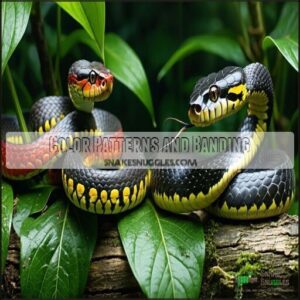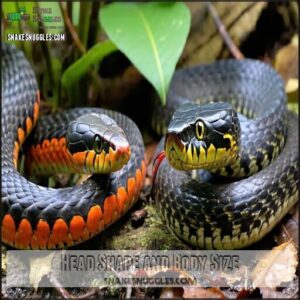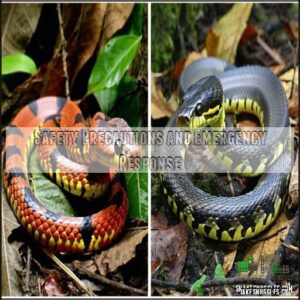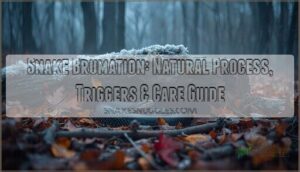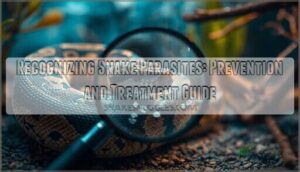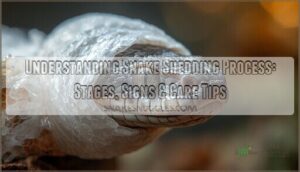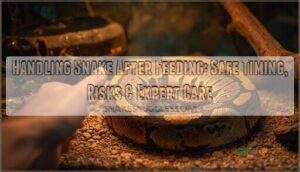This site is supported by our readers. We may earn a commission, at no cost to you, if you purchase through links.
 When you’re out hiking and spot a colorful snake, you’ll want to know the key differences between coral and king snakes.
When you’re out hiking and spot a colorful snake, you’ll want to know the key differences between coral and king snakes.
While they look similar with red, yellow, and black bands, coral snakes are venomous killers, while king snakes are harmless mimics.
Remember the rhyme: "Red touches yellow, you’re a dead fellow; red touches black, friend of Jack."
Coral snakes have bright, sequential red and yellow bands that touch, whereas king snakes have red bands separated by black.
Their similar appearance is nature’s clever survival strategy – king snakes evolved to look like deadly coral snakes to ward off predators.
Curious about identifying these slithery look-alikes?
Table Of Contents
- Key Takeaways
- Identifying Coral Snakes and King Snakes
- Habitat and Geographical Distribution
- Diet and Prey Preferences
- Physical Characteristics and Behavior
- Venom and Bite Toxicity
- Safety Precautions and Emergency Response
- Frequently Asked Questions (FAQs)
- Are coral snakes poisonous?
- Is a king snake poisonous?
- What is the difference between a kingsnake and a coral snake?
- How can you tell a coral snake from a king snake saying?
- Is a coral snake deadlier than a rattlesnake?
- How can you tell a coral snake from a king snake?
- What is the old saying about coral snakes?
- What is the rhyme for king snakes and coral snakes?
- How venomous is a coral snake?
- Do coral snakes and king snakes hibernate?
- Conclusion
Key Takeaways
- Look for red and yellow bands touching to identify venomous coral snakes; red and black bands touching indicate harmless king snakes.
- Remember the rhyme: "Red touches yellow, kills a fellow; red touches black, friend of Jack" for quick identification.
- Coral snakes are venomous with neurotoxic venom, while king snakes are non-venomous constrictors that even eat venomous snakes.
- Coral snakes rely on stealth, while king snakes mimic venomous species and use dramatic defensive displays.
Identifying Coral Snakes and King Snakes
When you’re hiking or exploring nature, it’s essential to know how to distinguish between the venomous coral snake and the harmless king snake.
By learning their distinct color patterns and understanding key visual differences, you’ll be better equipped to stay safe and appreciate these fascinating reptiles in their natural habitats.
Color Patterns and Banding
When nature’s color palette paints a snake’s warning, you’ll want to decode its secret language. Look closely: coral snakes flash red and yellow bands touching, while king snakes show red and black in a safer dance.
This color sequence isn’t just random art—it’s mimicry evolution’s clever defense.
- Recognize color patterns as nature’s camouflage
- Understand regional variations in snake coloration
- Learn to spot aberrant patterns for safer encounters
Head Shape and Body Size
When spotting snake differences, head shape tells a vital story.
Coral snakes boast narrow skulls and slim bodies, while king snakes showcase broader heads and more muscular frames.
These snout differences and body length variations are key to accurate snake identification.
Your survival might depend on recognizing these subtle yet significant morphological distinctions.
Snout Shape and Scale Texture
After measuring head width and body shape, you’ll want to zero in on snout morphology and scale characteristics.
Coral snakes brandish slender, tapered snouts with smooth, glossy scales that shimmer with an almost iridescent quality. King snakes counter with blunt, rounded noses and a matte scale finish that dulls their vibrant patterns.
These subtle differences are key to snake identification – think of it like nature’s own microscopic fingerprint. Whether you’re a wildlife enthusiast or just want to stay safe, understanding these scale and snout nuances can help you distinguish between these fascinating reptilian cousins.
Tail Patterns and Behavior
After examining the distinctive head shapes, shift your gaze to the tail—a key identifier between these serpentine lookalikes.
King snakes showcase bold banding to their tail’s tip, while coral snakes maintain uniform coloration.
King snake tail wags mimic rattlesnake defensive displays, whereas coral snakes rely on stealth.
These tail characteristics offer critical clues for snake identification in the wild.
Habitat and Geographical Distribution
If you’re hiking through the diverse landscapes of North America, you’ll likely encounter king snakes and coral snakes in distinct yet sometimes overlapping regions.
Their geographical distribution ranges from dense forests and grasslands to sandy terrains and desert environments, making these fascinating reptiles a tribute to nature’s adaptability.
Coral Snake Habitats and Distribution
Like a phantom of the wilderness, the coral snake weaves through specialized habitats across diverse landscapes.
These elusive serpents thrive in environments that shield them from potential threats. Their Geographic Range spans southeastern United States, southwestern deserts, Central, and South America.
- Pine flatwoods offer dense forest cover
- Swampy terrains provide perfect camouflage
- Desert rocky outcrops create strategic hiding spots
- Rainforest floors host intricate leaf litter networks
- Coastal scrublands support their secretive lifestyle
Coral snakes expertly adapt to warm, humid regions, remaining masters of environmental concealment. They are a specialized species that has learned to survive in these areas.
King Snake Habitats and Distribution
North American king snakes roam widely, mastering diverse ecosystems from scorching deserts to lush forests.
Their remarkable Geographic Range spans multiple environments, showcasing incredible adaptability.
Different populations thrive across varied landscapes, revealing nature’s resilience.
| Region | Habitat Type | Population Density |
|---|---|---|
| Southwest | Desert | Moderate |
| Southeast | Forest | High |
| Midwest | Grasslands | Low |
| West Coast | Coastal | Variable |
| Northeast | Woodland | Sparse |
The table provides a detailed overview of the population density across different regions, highlighting the adaptability of North American king snakes in various habitats.
Overlapping Regions and Coexistence
When king snakes prowl through shared territories, they’ve mastered an incredible survival trick.
Batesian mimicry transforms them into living decoys, sporting colors that scream "danger" to potential predators.
Their coexistence reveals nature’s intricate dance of survival:
- Resource competition drives strategic positioning
- Evolutionary pressures shape unique adaptations
- Habitat sharing demands sophisticated interactions
- Camouflage becomes a life-saving strategy
Their intricate relationship guarantees ecological balance across diverse landscapes, from Florida’s humid forests to arid southwestern regions.
Diet and Prey Preferences
If you’ve ever wondered how coral snakes and king snakes hunt their prey, you’re in for a fascinating comparison of their unique dietary strategies.
These two snake species may look similar, but their hunting techniques and food preferences reveal remarkable differences that’ll help you understand their distinct survival approaches.
Coral Snake Prey and Hunting Habits
Every coral snake’s hunting strategy is a precision-driven performance of survival.
— A venomous dance of survival, where every strike is calculated and every movement whispers nature’s deadly precision.
These slender predators use potent neurotoxins to immobilize prey quickly, targeting small lizards, frogs, and other reptiles with surgical accuracy.
During hunting time, they rely on venom usage as their primary weapon, paralyzing victims almost instantly.
Juvenile coral snakes start with smaller prey, gradually expanding their diet as they grow.
Their seasonal variation in hunting reflects the dynamic ecosystem they inhabit, making them masters of adaptation in their intricate natural world, utilizing their venom to ensure survival.
King Snake Prey and Hunting Techniques
Master hunters of the snake world, king snakes excel at conquering prey through remarkable constriction strength and venom resistance.
These nonvenomous snakes have evolved impressive hunting strategies that let them thrive across diverse environments.
Their versatile snake diet includes a wide range of targets:
- Rodents scurrying through underbrush
- Venomous and nonvenomous snake species
- Tiny lizards darting between rocks
- Nestling birds in hidden nests
- Small mammals wandering unwarily
Juvenile diets start smaller, gradually expanding as the snake grows.
What sets king snakes apart is their unique ability to consume other snake species, making them nature’s ultimate predators.
Their adaptability guarantees survival in environments where other predators might struggle, turning them into ecological champions of prey variety.
King snakes are also ambush predators, waiting patiently for their next meal.
Physical Characteristics and Behavior
You’ll encounter two snake species with remarkably similar color patterns that can trick even seasoned nature enthusiasts.
Understanding their distinctive physical characteristics and behaviors could mean the difference between a harmless encounter and a potentially dangerous situation.
Coral Snake Body Shape and Movement
With their lithe, serpentine bodies, coral snakes showcase remarkable muscular structure and scale arrangement.
Their locomotion style reveals incredible flexibility, allowing them to navigate through dense undergrowth with snake-like grace.
These slender predators utilize sophisticated burrowing adaptations, weaving seamlessly between leaf litter and tight spaces.
Their anatomy enables precise, fluid movements that prioritize stealth over strength.
Unlike their more robust counterparts, coral snakes move with an almost dancer-like precision, their smooth scales and rhythmic tail movements creating a mesmerizing display of natural engineering.
King Snake Body Shape and Movement Patterns
Slithering through nature’s obstacle course, these serpentine athletes showcase remarkable movement skills. Their body shape is a marvel of reptilian engineering, designed for survival and stealth.
King snakes: nature’s stealthy serpents, masters of survival in the wild’s intricate dance.
The king snake’s movement patterns reveal impressive adaptations:
- Scale Flexibility allows seamless navigation through complex terrains
- Constriction Strength enables precise body control
- Climbing Ability lets them explore diverse environments
- Speed and Agility make them formidable predators
With muscular bodies and smooth scales, they can glide over rocks, weave through underbrush, and change direction instantaneously. Their snake behavior demonstrates an evolutionary masterpiece of movement—silent, efficient, and perfectly adapted to their wild habitat.
Understanding snake locomotion techniques reveals how they thrive, showcasing their ability to thrive in complex environments with silent and efficient movement.
Defensive Behaviors and Threat Responses
Under and across their defensive landscapes, coral and king snakes showcase dramatically different survival strategies.
Coral snakes wag their tails and rely on venom threats, while king snakes employ elaborate mimicry—hissing, flattening their bodies, and shaking to intimidate predators.
Their strike accuracy varies, with king snakes prioritizing dramatic displays over actual confrontation, using snake mimicry as their primary defensive behavior.
Venom and Bite Toxicity
When you’re face-to-face with a coral snake or a king snake, you’ll want to know the critical difference that could save your life: venom.
While king snakes are harmless constrictors that’ll squeeze their prey, coral snakes pack a potent neurotoxic punch that can paralyze you within hours of a bite.
Coral Snake Venom Composition and Effects
Unraveling the neurotoxic prowess of coral snake venom reveals a complex biological weapon.
Its potent neurotoxins deliver a swift, silent attack on your nervous system.
Here’s what you need to know:
- Venom Mechanism: Paralyzes nerve signals within minutes
- Toxic Cocktail: Disrupts neuromuscular communication
- Symptom Progression: Causes progressive muscular weakness
- Critical Response: Immediate medical intervention is essential
King Snake Bite Characteristics and Safety
After unraveling the neurotoxic world of coral snake venom, let’s explore king snake bite safety. Unlike their venomous cousins, king snakes are harmless friends in the reptile kingdom.
Their bite might startle you, but it won’t send you to the hospital. Here’s what you need to know:
- Bite symptoms include minor pain and slight redness
- No venom means no serious medical complications
- Wash the wound to prevent potential infection
- Respect their space and avoid unnecessary handling
King snakes typically bite defensively, with minimal bite force. Their constriction risk is low for humans, making them surprisingly pet-friendly when handled correctly.
Remember, these nonvenomous serpents are more scared of you than you’re of them, and it’s essential to respect their space.
First Aid and Medical Treatment for Coral Snake Bites
A coral snake bite demands immediate, precise action. Your swift response can mean the difference between life and death.
Recognizing bite symptoms like muscle weakness, blurred vision, or numbness is essential. Don’t attempt outdated first-aid techniques like cutting or sucking the wound. Instead, keep the affected area below heart level and remain calm.
Cleaning the bite gently with soap and water is a recommended first aid step. Emergency medical professionals will administer antivenom and monitor your condition.
Prevention is always better than treatment, so stay alert in snake-prone environments and wear protective clothing when hiking or exploring wilderness areas.
| Action | Priority | Time Frame |
|---|---|---|
| Call 911 | Highest | Immediately |
| Immobilize Limb | High | Within Minutes |
| Clean Wound | Medium | Gently |
| Remove Jewelry | Medium | Quickly |
Safety Precautions and Emergency Response
When encountering snakes in the wild or near your home, understanding safety precautions can mean the difference between life and death.
You’ll want to learn how to identify venomous coral snakes, recognize potential bite symptoms, and know exactly what steps to take in a medical emergency.
Prevention and Avoidance Techniques
Snake encounters can catch you off guard, but smart prevention is your best defense.
Here’s how to stay safe:
- Snake-proof your territory by sealing entry points, maintaining short grass, and keeping woodpiles away from your home’s foundation.
- Dress for defense with sturdy boots, thick pants, and high socks when exploring snake-prone areas like trails and wooded regions.
Stay alert, learn snake identification, and remember: knowledge is your best protective gear against unexpected slithery surprises.
To bolster your defenses, consider home snake prevention methods.
Removing Snakes From Homes and Yards
Your backyard sanctuary might become an unexpected snake staging ground—but don’t panic. When encountering unwelcome serpentine visitors, safe relocation is key.
Always wear thick gloves and closed shoes before attempting snake removal. Use a long snake hook or sturdy stick to gently guide the snake away from high-traffic areas.
If you’re uncertain about snake identification, call professional removal experts immediately. Consider using specialized handling equipment for safer snake control.
Preventative measures are essential: seal potential entry points around your home’s foundation, maintain a tidy yard by removing debris and tall grass, and consider snake repellents designed for your specific region.
Regular yard maintenance reduces snake encounters, creating a safer outdoor environment. Remember, most snakes aren’t looking for a confrontation—they’re just passing through.
Recognizing Coral Snake Bites and Seeking Medical Help
React swiftly if a venomous coral snake strikes. These serpents deliver potent neurotoxins that can quickly paralyze your respiratory system, transforming a seemingly minor bite into a life-threatening emergency.
Remember, red touching yellow indicates a coral snake.
- Stay laser-focused and control panic to slow venom spread
- Strip off constricting jewelry before swelling sets in
- Position the bite below heart level for better circulation
- Race to a hospital equipped with specialized antivenom
Your quick action could mean the difference between life and death.
Frequently Asked Questions (FAQs)
Are coral snakes poisonous?
When push comes to shove, coral snakes are indeed poisonous—their neurotoxic venom can cause serious harm.
You’ll want to steer clear and seek immediate medical help if bitten, as their bite can lead to paralysis and breathing difficulties.
Is a king snake poisonous?
No, king snakes aren’t poisonous.
You’ll be safe around these helpful reptiles.
They’re non-venomous constrictors that actually help control rodent populations and can even eat venomous snakes, making them valuable backyard companions.
What is the difference between a kingsnake and a coral snake?
Looks can be deceiving! Coral snakes have red and yellow bands that touch, delivering venom through neurotoxins.
Kingsnakes, non-venomous constrictors, sport red and black bands touching, mimicking coral snakes for protection.
Remember: ‘Red touches black, friend of Jack.’
How can you tell a coral snake from a king snake saying?
Remember the rhyme: "Red touches yellow, kills a fellow.
Red touches black, friend of Jack." It highlights how coral snakes’ red and yellow bands touch, while king snakes’ red bands touch black instead, which is a key point to remember.
Is a coral snake deadlier than a rattlesnake?
Imagine a silent predator lurking—coral snakes are venomous, but rattlesnakes are deadlier due to their larger venom yield and aggressive defense.
Coral snake bites are rare but still demand immediate medical attention for their neurotoxicity.
How can you tell a coral snake from a king snake?
You can tell them apart by their bands: coral snakes have red and yellow touching, while king snakes have black separating red and yellow.
Also, coral snakes have black heads, whereas king snakes don’t.
What is the old saying about coral snakes?
The old saying goes, "Red touches yellow, kills a fellow.
Red touches black, friend of Jack."
It helps you identify venomous coral snakes, where red and yellow bands touch, unlike harmless king snakes.
What is the rhyme for king snakes and coral snakes?
The rhyme goes, "Red touches yellow, kills a fellow; red touches black, friend of Jack."
It helps you distinguish venomous coral snakes (red and yellow bands touch) from harmless king snakes (red and black bands touch).
How venomous is a coral snake?
A coral snake’s venom is highly potent, packed with neurotoxins that can paralyze muscles and disrupt breathing.
Though bites are rare, symptoms may take hours to appear, so immediate medical attention is absolutely critical.
Do coral snakes and king snakes hibernate?
Like nature’s clock winding down for winter, both coral snakes and king snakes enter brumation—a hibernation-like state.
They retreat underground or into sheltered spots, conserving energy until warmer weather signals activity again, which is a natural part of their hibernation.
Conclusion
How can you confidently tell a coral snake from a king snake?
By focusing on their distinct patterns, behaviors, and habitats, you’ll stay safe and informed.
Remember, coral snakes have red and yellow bands that touch, while king snakes’ red bands are separated by black.
Coral snakes are venomous, requiring caution, while king snakes are harmless.
Understanding these differences in the "coral snake vs king snake" comparison helps you appreciate nature while avoiding unnecessary risks outdoors.

